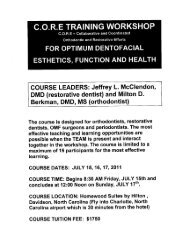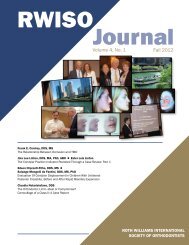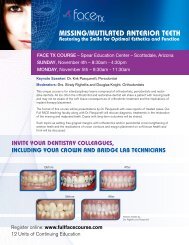2010 RWISO Journal - Roth Williams International Society of ...
2010 RWISO Journal - Roth Williams International Society of ...
2010 RWISO Journal - Roth Williams International Society of ...
Create successful ePaper yourself
Turn your PDF publications into a flip-book with our unique Google optimized e-Paper software.
points. They found that the mean distance between any two<br />
points was 1.1 mm. More than 96% <strong>of</strong> predetermined points<br />
were within 2 mm <strong>of</strong> the true hinge axis. 23 Schallhorn also<br />
found that approximately 98% <strong>of</strong> all true anatomical hinge<br />
axis points were within a 5-mm radius. 26<br />
In comparison, studies that compared maxillary cast positions<br />
mounted with four different face-bows showed wide<br />
variation in the mounted maxillary cast positions. All arbitrary<br />
hinge axis points deviated from the true hinge baseline<br />
point by anywhere from 1.5 mm to 4 mm. Therefore, the<br />
authors <strong>of</strong> these studies concluded that it was not possible<br />
to establish the clinical superiority <strong>of</strong> one arbitrary face-bow<br />
over another. 28,29<br />
Lauritzen and Bodner located 100 true hinge points on<br />
50 subjects. They found that 67% <strong>of</strong> the axis points were<br />
5 mm to 13 mm away from the arbitrarily marked hinge<br />
points. This discrepancy may introduce gross errors in the<br />
mounting <strong>of</strong> the casts on an articulator, resulting in large<br />
occlusal errors. 30 Palik et al got similar results. They found<br />
that only 50% <strong>of</strong> the arbitrary hinge axes located with the<br />
arbitrary earpiece face-bow were within a 5-mm radius <strong>of</strong><br />
the terminal hinge axis. This indicated that the arbitrary<br />
earpiece face-bow hinge axis location does not represent the<br />
total population. 31 Schulte et al concluded from their study<br />
that errors in locating the arbitrary hinge axis will produce<br />
a three-dimensional occlusal error. 32 This study and others<br />
have recommended that if a thick vertical dimension <strong>of</strong> wax<br />
was used for an interocclusal record, or if the vertical dimension<br />
will be changed with treatment, a true hinge axis should<br />
be located on the patient. 32,33 Due to anatomical variations,<br />
the arbitrary earpiece face-bow may introduce significant errors<br />
in an A-P or vertical dimension, resulting in mandibular<br />
displacement. 34,35 The only way to be relatively certain that<br />
errors due to malpositioning <strong>of</strong> maxillary casts on an articulator<br />
have been avoided is to locate the true hinge axis. 30,36-40<br />
Studies indicate that coincidence between the two hinge<br />
axis points does not usually occur. 41 This results in a discrepancy<br />
between the arbitrary hinge axis and the true hinge axis<br />
points. This discrepancy will cause changes in the mounted<br />
position <strong>of</strong> the maxillary cast, which in turn can produce a<br />
positional change <strong>of</strong> all teeth in the three planes <strong>of</strong> space. 41<br />
Zuckerman mathematically demonstrated that discrepancies<br />
between the true hinge axis and the arbitrary hinge axis points<br />
can produce changes in the A-P direction <strong>of</strong> the occlusion. He<br />
verified in his analog tracing that the arc <strong>of</strong> the incisal edge<br />
does not change in the A-P direction in centric occlusion, as<br />
long as the mandible is also coincident in centric relation.<br />
However, when an error in the arbitrary hinge axis occurs<br />
and it is anterior to the true hinge, the incisor arc <strong>of</strong> closure<br />
is anterior to the actual arc <strong>of</strong> closure. 41 Errors in the verti-<br />
cal position <strong>of</strong> the arbitrary hinge axis (AHA) produce the<br />
largest A-P discrepancies upon mandibular closing. 41 Other<br />
authors have graphically illustrated how errors in true hinge<br />
axis location can produce occlusal aberrations. 33,35,36,42 These<br />
authors also showed that the greatest errors occurred when<br />
the hinge axis was incorrectly located in a vertical direction<br />
perpendicular to the correct hinge axis closure. An arbitrary<br />
hinge axis positioned superior to the true hinge axis also<br />
produced premature contacts on the anterior teeth. In addition,<br />
if the arbitrary hinge axis was placed inferior to the true<br />
hinge axis, premature posterior contacts occured. 33,35,36,42<br />
Brotman’s geometric representation related changes in<br />
the hinge axis point locations between the true hinge axis<br />
and the arbitrary axis to differences produced at the occlusal<br />
level in mounted casts. 43 Brotman concluded that “if the<br />
hinge axis has been improperly located by as much as 3 mm,<br />
the error at the occluding position <strong>of</strong> the casts (anteroposteriorly)<br />
will be about .09 mm or less than 1/250 inch.” 43<br />
Gordon et al looked at the location <strong>of</strong> the terminal hinge<br />
axis and its effect on the second molar cusp position on the<br />
position <strong>of</strong> the second molar cusp. 6 Their results showed that<br />
incorrect anterior location <strong>of</strong> the hinge axis produced the effect<br />
<strong>of</strong> having moved the mandibular arch backward. Incorrect<br />
posterior location <strong>of</strong> the hinge axis produced the effect<br />
<strong>of</strong> having moved the mandibular arch forward. Incorrect inferior<br />
location <strong>of</strong> the hinge axis caused slight retrusion <strong>of</strong> the<br />
mandibular cast with premature posterior contacts. Incorrect<br />
superior location <strong>of</strong> the hinge axis caused protrusion <strong>of</strong> the<br />
mandibular cast with premature anterior contacts. 6<br />
Since studies vary in reporting the percentage <strong>of</strong> placement<br />
<strong>of</strong> the arbitrary hinge axis less than 5 mm from the true<br />
hinge axis, it can be assumed that larger errors in occlusion<br />
may occur. It has been found that an occlusal discrepancy <strong>of</strong><br />
0.01 inch can cause pulpitis or periodontal disease, though<br />
the patient may not be able to detect so small a discrepancy. 44<br />
To limit occlusal errors in mountings, it is necessary to locate<br />
the hinge axis to within 1 mm, and the kinematic true hinge<br />
can be done to this degree <strong>of</strong> accuracy. 44 Therefore, the importance<br />
<strong>of</strong> the true hinge axis is substantial when changing<br />
the vertical dimension upon mandibular closure. 38<br />
Orthodontics deals specifically with the movement <strong>of</strong><br />
all teeth and their occlusal fit. Therefore, it calls for extreme<br />
accuracy during diagnosis, treatment planning, and rendering<br />
treatment. 9 Clinically finding the true hinge axis may be<br />
the only way to ensure a reproducible and accurate starting<br />
point—one from which optimum esthetic and functional results<br />
can be obtained. 6,38,45 The purpose <strong>of</strong> this study was to<br />
compare the maxillary cast mountings <strong>of</strong> 51 patients in three<br />
planes <strong>of</strong> space when mounted using a true hinge axis facebow<br />
versus an arbitrary earpiece face-bow.<br />
<strong>RWISO</strong> <strong>Journal</strong> | September <strong>2010</strong><br />
47








